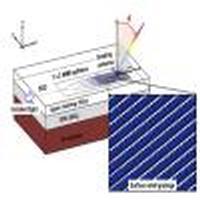当前位置:
X-MOL 学术
›
Opt. Express
›
论文详情
Our official English website, www.x-mol.net, welcomes your
feedback! (Note: you will need to create a separate account there.)
Silicon nitride optical phased array based on a grating antenna enabling wavelength-tuned beam steering.
Optics Express ( IF 3.2 ) Pub Date : 2020-02-03 , DOI: 10.1364/oe.383304 Chul-Soon Im , Bishal Bhandari , Kyeong-Pyo Lee , Sung-Moon Kim , Min-Cheol Oh , Sang-Shin Lee
Optics Express ( IF 3.2 ) Pub Date : 2020-02-03 , DOI: 10.1364/oe.383304 Chul-Soon Im , Bishal Bhandari , Kyeong-Pyo Lee , Sung-Moon Kim , Min-Cheol Oh , Sang-Shin Lee

|
An optical phased array (OPA) in silicon nitride (SiN) is conspicuously highlighted as a vital alternative to its counterpart in silicon. However, a limited number of studies have been conducted on this array in terms of wavelength-tuned beam steering. A SiN OPA has been proposed and implemented with a grating antenna that incorporated an array of shallow-etched waveguides, rendering wavelength-tuned beam steering along the longitudinal direction. To accomplish a superior directionality on a wavelength-tuned beam steering, the spectral beam emission characteristics of the antenna have been explored from the viewpoint of a planar structure that entails a buried oxide (BOX), a SiN waveguide core, and an upper cladding. Two OPA devices having substantially different thicknesses of the resonant cavities, established by combining the BOX and SiN core, were considered theoretically and experimentally to scrutinize the spectral emission characteristics of the antenna on beam steering. Both of the fabricated OPA devices steered light by an angle of 7.4° along the longitudinal direction for a wavelength ranging from 1530 to 1630 nm, while they maintained a divergence angle of 0.2°×0.6° in the longitudinal and lateral directions. Meanwhile, the OPA fabricated on a substantially thick BOX layer featured a limited steering performance to attain a stabilized response over a broad spectral region. We examined the influence of the cavity thickness on the spectral response of the antenna in terms of optical thickness. Based on the two antenna characteristics, it was confirmed that the grating antenna emitted the beam with a higher efficiency when the optical thickness of the cavity corresponded to odd integer multiples of the quarter wavelength. This work is a considerable strategy for designing a stabilized SiN OPA over a desired spectral region.
中文翻译:

基于光栅天线的氮化硅光学相控阵,可进行波长调谐的光束控制。
氮化硅(SiN)中的光学相控阵(OPA)明显地突出了其替代硅中的光学相控阵的重要选择。然而,就波长调谐的光束控制而言,已经对该阵列进行了有限的研究。已经提出并利用光栅天线来实现SiN OPA,该光栅天线结合了浅蚀刻波导阵列,使得沿波长方向的波长调谐光束转向。为了在波长调谐波束控制上实现优异的方向性,已经从需要掩埋氧化物(BOX),SiN波导芯和上包层的平面结构的角度研究了天线的频谱束发射特性。通过组合BOX和SiN磁芯建立的两个OPA器件,其谐振腔的厚度基本不同,在理论上和实验上都经过仔细研究,以仔细研究波束转向时天线的频谱发射特性。所制造的两种OPA器件均沿纵向方向将光转向7.4°角,波长范围为1530至1630 nm,而它们在纵向和横向方向上均保持0.2°×0.6°的发散角。同时,在相当厚的BOX层上制造的OPA具有有限的操纵性能,无法在较宽的光谱范围内获得稳定的响应。我们从光学厚度的角度研究了腔体厚度对天线频谱响应的影响。根据两个天线的特性,可以确定的是,当腔的光学厚度对应于四分之一波长的奇数整数倍时,光栅天线会以更高的效率发射波束。这项工作是在所需光谱区域上设计稳定的SiN OPA的重要策略。
更新日期:2020-02-03
中文翻译:

基于光栅天线的氮化硅光学相控阵,可进行波长调谐的光束控制。
氮化硅(SiN)中的光学相控阵(OPA)明显地突出了其替代硅中的光学相控阵的重要选择。然而,就波长调谐的光束控制而言,已经对该阵列进行了有限的研究。已经提出并利用光栅天线来实现SiN OPA,该光栅天线结合了浅蚀刻波导阵列,使得沿波长方向的波长调谐光束转向。为了在波长调谐波束控制上实现优异的方向性,已经从需要掩埋氧化物(BOX),SiN波导芯和上包层的平面结构的角度研究了天线的频谱束发射特性。通过组合BOX和SiN磁芯建立的两个OPA器件,其谐振腔的厚度基本不同,在理论上和实验上都经过仔细研究,以仔细研究波束转向时天线的频谱发射特性。所制造的两种OPA器件均沿纵向方向将光转向7.4°角,波长范围为1530至1630 nm,而它们在纵向和横向方向上均保持0.2°×0.6°的发散角。同时,在相当厚的BOX层上制造的OPA具有有限的操纵性能,无法在较宽的光谱范围内获得稳定的响应。我们从光学厚度的角度研究了腔体厚度对天线频谱响应的影响。根据两个天线的特性,可以确定的是,当腔的光学厚度对应于四分之一波长的奇数整数倍时,光栅天线会以更高的效率发射波束。这项工作是在所需光谱区域上设计稳定的SiN OPA的重要策略。











































 京公网安备 11010802027423号
京公网安备 11010802027423号